While lawns have their place, at least part of the garden floor needs paving or some kind of hard surface to make it easy to move around in, and to create outdoor sitting and dining areas. In smaller gardens, every inch of space is valuable, particularly if you like to entertain outside. A hard surface is essential for this. When choosing hard surface materials, remember the golden rule: Simplicity is key. A mix of too many materials on the floor of a garden (or anywhere for that matter) just looks confused, particularly in smaller gardens.
A good starting point for choosing materials for your outdoor ground surfaces is the external walls of the house and the boundary structures, and other materials already being used in the garden. For instance, if the garden is surrounded by concrete walls, you could use concrete flagstones with a different surface texture as paving. Or use wood inserts in a new area of poured concrete to connect it to an existing wood deck. Remember that garden floors are not always level. If steps are needed, this will affect what materials you use for the areas that connect to the steps.
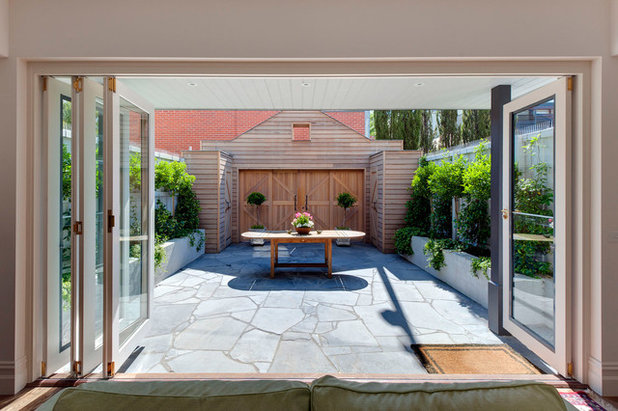
Whetstone Windows & Doors
Crazy PavingIt was big in ancient Rome, then again in the 1950s. Now crazy paving is making another comeback in gardens. Irregularly sized paving stones are laid dry or mortared onto a flat surface to create an organic, eye-catching garden floor. The curved shapes are a perfect counterpoint to the rectilinear geometry of many urban gardens, like this one in Sydney. Crazy paving suits contemporary, Mediterranean, coastal and other informal garden styles.
Pros: This kind of paving gives a unique look, as the shape and often the color of each slab are different. The curved lines are gentler on the eye than regular pavers too.
Cons: You will need a skilled installer to lay the pavers, and natural stone can be expensive.
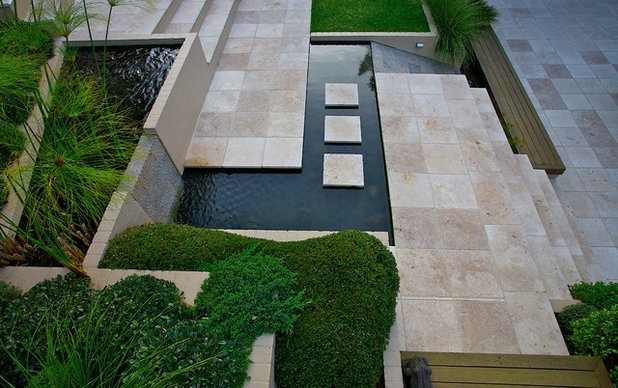
Art in Green
TravertineIf you’re going to go for natural stone, then travertine is one of the best paving materials to use around a pool. This is due to its porous surface — it will absorb water quickly, so the surface is virtually nonslip. Travertine pavers also don’t heat up like other paving materials such as brick and concrete do.
Pros: Travertine is incredibly long-lasting, and is available in a wide range of colors and patterns, with warm tones that work well with plantings. They’re nonslip, they can be either smooth or textured, and they suit both contemporary and European-style gardens.
Cons: The stone can be expensive and is porous, so it may need to be sealed, and the surface can be rough on bare feet. You will also need a skilled installer.
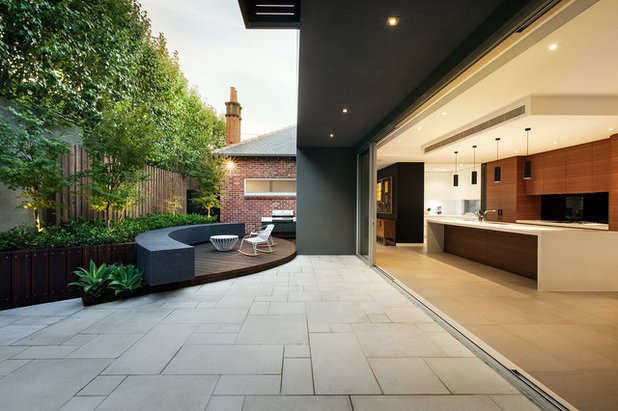
Anston Architectural
Reconstituted StoneMade from concrete mixed with stone aggregates, reconstituted stone is a great way to get the look of natural stone without the price. It works very well when laid in a traditional stone pattern, as the Ashlar used here is; these Granite Range Vega pavers are made with reconstituted Australian black granite flecks within a light gray base.
Pros: It’s cheaper than natural stone and available in a wide range of colors, and it comes in consistent thicknesses and textures.
Cons: The pavers can fade (although the weathered look is often seen as a plus) and become marked.
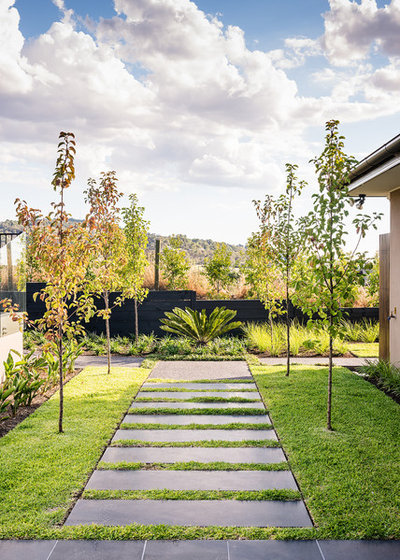
Apex Landscapes & Pools
Bluestone The gray tones of bluestone, or basalt, complement green lawns and plantings. The honed bluestone steppingstones seen here are set into a lawn, allowing rainwater to permeate and creating a softer look than a solid path would. The classic simplicity of bluestone paving suits most garden styles.
Pros: Bluestone has an attractive color and comes in a wide range of sizes and shapes. Pavers can be cut to your own specifications, and you can choose from a range of surface finishes. They’re dense and hard-wearing, strong, slip-resistant and low-maintenance, and they don’t show marks.
Cons: This is an expensive option. You’ll need a skilled installer, and some stone may be sourced from unethical overseas quarries.
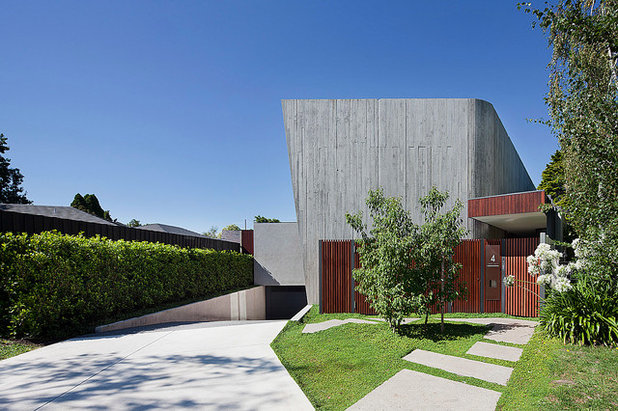
bg architecture
Concrete When you’re covering a large area that gets a high level of vehicular traffic, such as a driveway, concrete is often the best paving solution. This Melbourne, Australia, home demonstrates the versatility of concrete: The house is clad in textured concrete, and the same material with different colors and finishes has been used for the irregularly shaped driveway and the mix of different-size paving units in the pathway.
Pros: There is a huge range of colors, textures and finishes available for concrete, and virtually any shape is possible. The material is long-lasting and durable, looks great combined with other materials such as timber, terra cotta, stone and brick, and can be cut to resemble large pavers.
Cons: Professional skill is needed for a quality job, and concrete needs to be cleaned regularly in humid or wet locations.
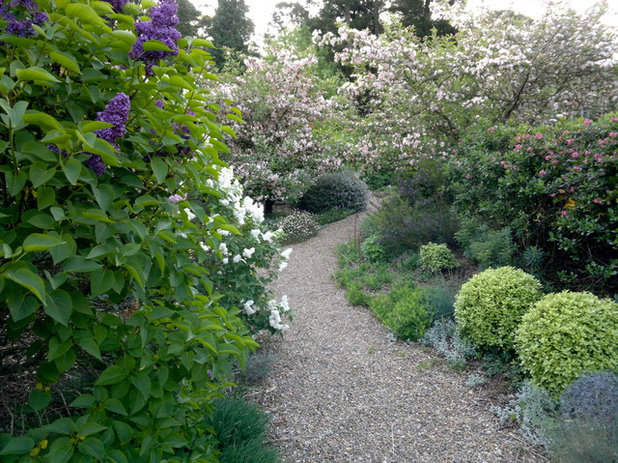
Arthur Lathouris Garden Designer
Gravel Gravel and other “soft” paving materials, such as pebbles, stone chips and shells, are ideal for secondary or low-traffic pathways. Adding an attractive textured look to the garden, gravel does still need to be retained with some kind of edging. And although it can be noisy, this is said to be a good burglar deterrent.
To make gravel more stable, select small-grade stones and avoid rounded, tumbled pea gravel. Sharper, angular gravel interlocks to form a firmer surface, and using a roller to compress also helps stability. This look suits informal garden styles such as cottage, beach and naturalistic.
Pros: Gravel paths drain well. Plants can be grown into this material to soften the look, and it’s a good environmental choice, as rainwater doesn’t run off it and into stormwater drains. It’s also one of the cheapest paving options, with only basic DIY skills required to install it.
Cons: Paths can get weedy if not properly maintained, and gravel is generally too uneven and unstable for outdoor seating or tables. Some gravel can also be too sharp to walk on barefoot, and it can be tracked indoors.
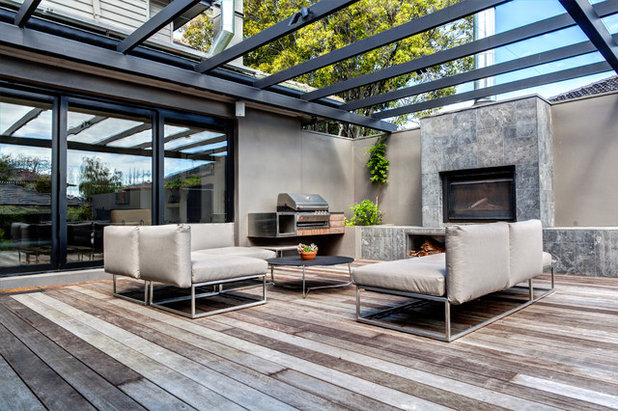
White Chalk Interiors
Decking and BoardwalksWood decking provides a good visual connection to wood-clad houses or ones with wood flooring. It is also an excellent way to disguise level changes, and boardwalks are especially good for boggy terrain. Wood decking is so versatile, it suits most garden styles.
Pros: A wide range of decking finishes, colors and board sizes is available, and decking can be built with a medium level of DIY skill. There are even ready-made wood decking sections available.
Cons: Wood needs to be regularly treated to reduce slipperiness from mold, and some wood decking can be unethically sourced from rain forests.

ANNA CARIN Design
Composite DeckingAn environmentally sustainable alternative to wood decking is composite decking, such as the ModWood used here. An Australian-made composite product, ModWood is a mixture of ground wood waste and recycled plastic milk bottles. It contains no formaldehydes and comes in a range of sizes, colors and finishes. Like timber decking, it suits most gardens.
Pros: ModWood is sustainable, versatile, easy to install, durable, splinter-free and resistant to insects such as termites, and requires little maintenance. It’s also just as stable as timber.
Cons: It’s not real wood, just a lookalike, but is more expensive than most decking wood.
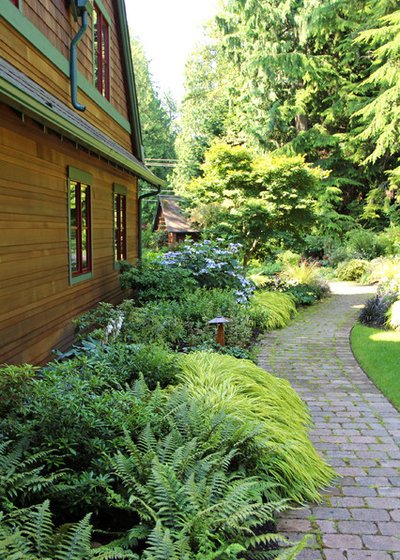
Bliss Garden Design
Cobbles or Setts The small size of cobbles and setts makes them ideal for curved paths like this one, as well as edging and decorative details in gardens. Most cobbles and setts are made from concrete, granite or bluestone, ensuring their durability and hardness. They’re used mainly in informal country or cottage gardens, but also suit courtyards.
Pros: Cobbles and setts are hard-wearing, slip-resistant, versatile and easy to remove if damaged when laid on sand.
Cons: Professional skill is needed for installation in large areas.
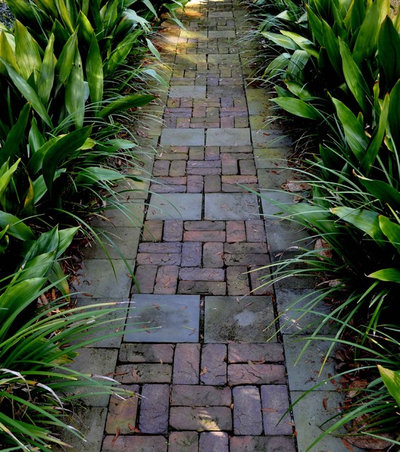
Frederick + Frederick Architects
Brick Recycled or old bricks have character and warmth, and work beautifully with other materials such as gravel or concrete and plantings.
Pros: They can be used in a variety of patterns, are available in a wide range of colors, have a nonslip surface and aren’t as expensive as stone paving.
Cons: Bricks aren’t always easy to obtain, and large bricked areas can look too busy for most contemporary styles. A reasonable level of skill is also needed to install them.
Your turn: Share your experiences with paving and decking materials in the Comments below.





